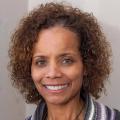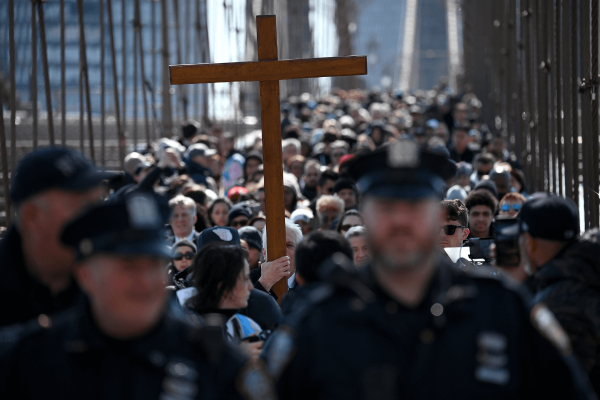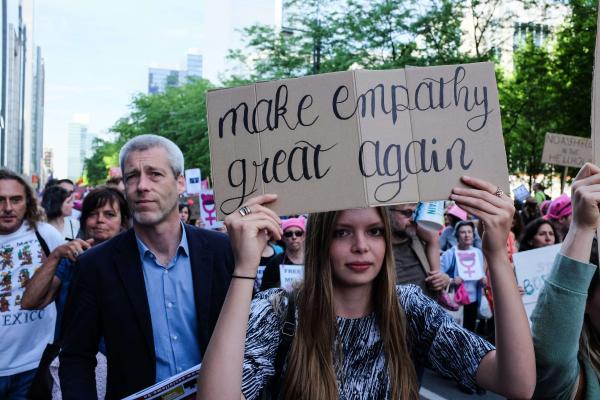Ten years ago, Michael Brown, an unarmed Black teenager, was killed by a police officer in Ferguson, Mo. Young people gathered at the local police station refusing to accept this as just another “unfortunate incident.” They demanded answers and accountability; their determined stance sparked a movement for racial justice that this nation had not experienced in decades.
At the time, I was a seminary professor in St. Louis, less than 20 miles from Ferguson. I joined the local clergy, justice leaders, and other concerned citizens who responded to the call the young people issued, participating in protest marches, die-ins, and other actions throughout the city. In the days and weeks that followed Brown’s death on Aug. 9, 2014, pastors preached about racial injustice in their pulpits and marched alongside activists in the streets; congregations held crucial conversations about race and offered safe space for protesters to eat meals, charge their phones, and rest between marches.
Network news stations from around the world broadcast images of the militarized response to the mostly nonviolent St. Louis protests. But unlike previous civil rights movements, this movement was not dependent on network news to tell its story. Using social media, people close to the action were able to document and share their point of view — which often conflicted with media narratives that framed the protesters as violent agitators. While news coverage emphasized the tanks, tear gas, and occasional heated exchanges between police and protesters, I saw thousands of people marching peacefully without any negative incidents. I also saw clergy and young activists working together. In an interview for my first book, Faith in Ferguson, in which I talked with many clergy and activists who participated, one activist told me she always thought you went to church to look for Jesus — but she saw Jesus on the streets when pastors stood up alongside protesters.
Today, we know that the movement ignited in Ferguson grew; we also know that the killings of unarmed Black people by police officers around the country have, unfortunately, continued. Where are we now and where do we go from here? It’s a question I keep asking myself. In my second book, Faith After Ferguson: Resilient Leadership in Pursuit of Racial Justice, I followed up with more than a dozen clergy and young activists to hear their perspectives about what has happened since the uprising began. They told me stories of resilience: Building community and networks; working with intergenerational, interreligious, interracial coalitions to push for political change; and for some, reimagining what it means to be church in the 21st century.
I saw an example of this intergenerational coalition in 2014. During one of the marches near St. Louis University, an older pastor was marching alongside some of the young activists who were chanting familiar slogans: “What do we want? Justice! When do we want it? Now!” However, during this march, some of the young people added a bit of colorful language, including a few expletives, prompting the pastor to say in a friendly, grandfatherly kind of way, “Language, Language!” Then he turned to another pastor and said, “But the kids have done it! They are making justice possible!”
Now, a decade after Michael Brown’s death, when I think about where we are and what’s next, I think about how the backlash to the movement for racial justice has been swift, expansive, and heavily financed. One particularly devastating aspect of this backlash is the contrived hysteria related to diversity, equity, and inclusion, or “DEI,” and the subsequent full-frontal assault on its relevance, efficacy, and importance for a just and inclusive society. During the Ferguson uprising, it became popular to use “woke” to describe how some felt that this was an “awakening” of sorts to the present-day issue of racial injustice; today the term has been co-opted by others who launched a well-funded campaign of “anti-wokeness,” resulting in the rollback of legislation and policies designed to protect against racial discrimination at the local, state, and federal levels. African American history courses have been removed from high school curriculums, teachers have been prohibited from talking about race, and school boards have banned books about lynching, Jim Crow laws, and school desegregations efforts.
Perhaps the gravest example of this trend is the Supreme Court’s decision to ban the affirmative action protections that allowed race to be a consideration in the higher education admission process. For centuries, race was used as a primary factor to legally discriminate against African Americans in higher education admissions, and the Civil Rights movement brought that to an end. African Americans, especially African American men, are already underrepresented in many colleges and universities. This ruling will only further exacerbate racial disparities in higher education and threaten economic advancements that often come through careers that require advanced degrees.
As efforts to roll back the tide of racial justice continue, our country is faced with a critical decision. Will we move forward to fully embrace, value, and celebrate the vast racial, ethnic, gender, differing abilities, language, and religious diversity that already defines our society? Or will we reinforce — in word and deed — a vision for our country that obscures these truths and the tremendous opportunities we have to recreate a more equitable, just, and inclusive society for all?
Middle ground evades us in this moment. The chasm between these choices is just too wide. Either we are willing to face the truth of our country’s difficult past, the dehumanization that ensued, and teach it to ensure that it is not repeated — or we aren’t. We will put policies of protections in place that make flourishing possible for those who have been discriminated against — or we won’t. For Christians, we either believe that all people are created in the image of God and their authentic self should be celebrated as such — or we don’t.
Where do we go from here? We must lean into the truth of who we are, creating pathways to a future filled with hope for our children, for all of our children. I once heard a pastor say that it’s more challenging to stand in the light of the truth than recline in the shade of a lie, but it is the challenge of our day. May we choose wisely.
Got something to say about what you're reading? We value your feedback!







